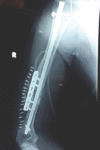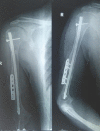Resistant Non-union of Humerus After Intramedullary Nailing Treated with Locking Compression Plate with Bone Grafting With Nail in Situ and Shoulder Spica: A Case Report
- PMID: 29242802
- PMCID: PMC5728007
- DOI: 10.13107/jocr.2250-0685.906
Resistant Non-union of Humerus After Intramedullary Nailing Treated with Locking Compression Plate with Bone Grafting With Nail in Situ and Shoulder Spica: A Case Report
Abstract
Introduction: Humerus non-union is a challenging situation for the surgeon and devastating and morbid situation for the patient. Surgical approach to the humerus is demanding because of the complex neurovascular anatomy and especially when previous surgeries have been attempted.
Case report: We report a case of a young adult male who sustained a compound fracture of humerus shaft treated with intramedullary nailing followed by subsequent bone grafting and eventually landed up in non-union and was treated at our center by locking compression plate application with nail in situ with iliac crest autogenous bone graft followed by shoulder spica application.
Conclusion: Although humerus nailing is a valid therapeutic option for humeral shaft fractures, compression plating is considered the gold standard and non-union secondary to failed interlocking nailing is a challenging situation.
Keywords: Non-union; compression plating; interlocking nailing.
Conflict of interest statement
Conflict of Interest: Nil
Figures






References
-
- Rommens PM, Kuechle R, Bord T, Lewens T, Engelmann R, Blum J, et al. Humeral nailing revisited. Injury. 2008;39:1319–28. - PubMed
-
- Egol KA, IKoval KJ, Zuckerman JD. Humeral shaft fractures. In: Egol KA, Koval KJ, Zuckerman JD, editors. Handbook of Fractures. 4th ed. Philadelphia, PA: Lippincott Williams & Wilkins; 2010. pp. 203–13.
-
- Foster RJ, Dixon GL, Bach AW, Appleyard RW, Green TM. Internal fixation of fractures and nonunions of the humeral shaft. J Bone Joint Surg (Am) 1985;67(A):857–65. - PubMed
-
- Foulk DA, Szabo RM. Diaphyseal humerus fractures: Natural history and occurrence of nonunion. Orthopedics. 1995;18:333–5. - PubMed
-
- Healy WL, White GM, Mick CA, Brooker AF, Jr, Weiland AJ. Nonunion of the humeral shaft. Clin Orthop Relat Res. 1987;219:206–13. - PubMed
Publication types
LinkOut - more resources
Full Text Sources
